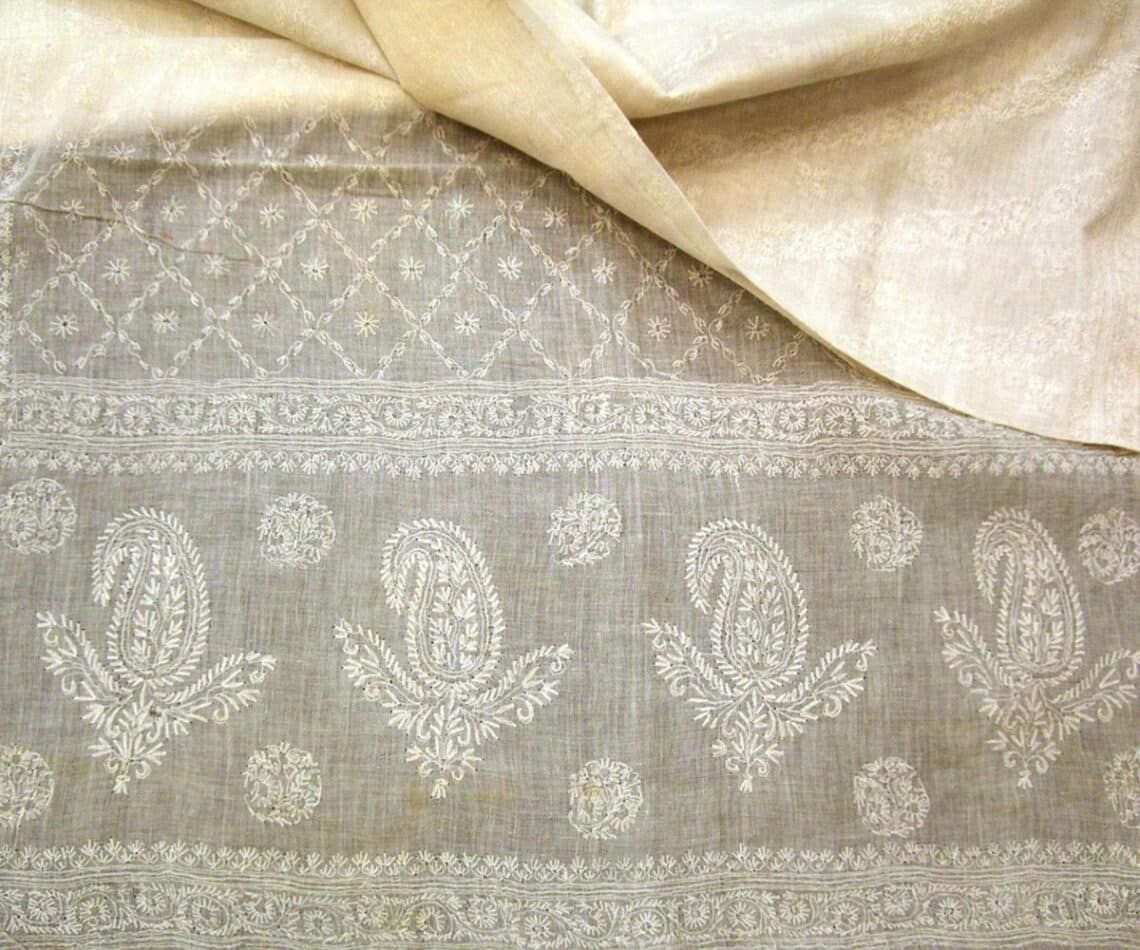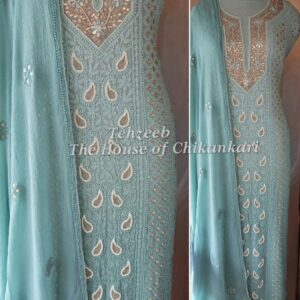
House of Chikankari: Unveiling the Secrets Behind Exquisite Embroidery
Chikankari specialty
Step into a world where every thread tells a story and every pattern sings a story song. Chikankari House stands not only as an advertisement but as the custodian of a centuries-old art form. Traditional Indian embroidery is not only preserved here; It is celebrated, nurtured and evolved. Chikankari with its subtle beauty and intricate details weaves the fabric of India’s rich cultural story.
Chikankari House: Carrying forward a valuable asset
-
Chikankari-property
History and Origins
Chikankari House takes great pride in being the torchbearer of an art form that has deep roots in ancient India. Known for its exquisite beauty and subtlety, Chikankari is often associated with the Nawab’s land in Lucknow. This delicate weaving style is believed to have flourished during the Mughal era under the patronage of Noor Jahan, wife of Emperor Jehangir.
Chinkari, however, is more than just embroidery and decoration; It symbolizes an interesting story told through fashion. The story begins in mythology, where Lord Krishna’s wife Radha is said to have expressed her love with unique colorful chikankari patterns embroidered on cloth This Connection imbues chikankari with divine substance and emotional meaning, and owes it and rich textiles of rich cultural heritage again Lucknow is situated.
Evolution Over the Years
Like a river that changes its course over time yet never abandons its source, Chikankari too went through various transformations over the centuries. Yet, it painstakingly preserved its original essence. Chikankari artisans of the past passed on their art to younger generations, ensuring that it continued with all its skill and fervour.
Notable figures in history have contributed to the popularity of this intricate craft over the years. British viceroys, Queen Victoria herself, and more recently, celebrities, and fashion designers have all played crucial roles in keeping Chikankari in the public consciousness.
In its nascent stages, Chikankari was typically portrayed in white-on-white embroidery on muslin cloth, epitomizing the essence of understated elegance. Over time, the craft embraced colored threads, sequins, beads, and various fabric types, transforming Chikankari into a versatile and appealing element in modern fashion.
Through the eye of the House of Chikankari, this beautiful amalgamation of past and present turns a simple piece of fabric into an alluring canvas. And as the world evolves, so do we, making sure the essence of Chikankari, the legacy of Kesari, continues to enthral generations to come.
-
The Craftsmanship of Chikankari: An Intricate Symphony of Stitches
Understanding the Art
When it comes to understanding the art of Chikankari, the process begins even before the first stitch is laid. The House of Chikankari starts its crafting journey with the selection of just the right fabric – one that holds onto the charm of the delicate stitches, absorbing the soul of Lucknow into its texture. Traditionally, fabrics like muslin, cotton, and silk have been used owing to their soft texture and durability.
The art features multiple unique stitches, each lending a distinctive texture to the piece. One such stitch, traditionally known as the “Bakhia” or the shadow work, stands as the backbone of Chikankari. Symbolic of Chikankari’s subtlety, Bakhia is an intricate technique where the thread’s shadow reflects on the cloth, creating a play of light and shade that brings the fabric to life.
The artist behind the craft
Behind every piece of Chikankari art from Chikankari House is an artist – patient, dedicated and full of unimaginable skill. They are quiet poets who tell stories through their work, weaving stories of tradition and heritage.
Becoming a Chikankari artisan is not a job but a professional journey, often passed down through generations. Their training usually begins at an early age, and they spend years mastering the details – from learning different fabrics to understanding patterns and knots
While it’s hard to put a number on the many unsung heroes nurturing this art form, an estimated 2.5 million artists across India are associated with Chikankari, according to the European Center for Development Policy and Management , sources that this art show succeeds on a global stage, spreading the appeal of our cultural heritage far and wide.
-
House of Chikankari Today
The House of Chikankari, rooted deeply in traditional artistry, is embracing the winds of change to sail towards modernity with grace and resilience. Today, this time-honored craft marries age-old techniques with contemporary influences, gracefully striding into the global fashion arena.
Modern Innovations
In the realm of Chikankari, modern technology and evolving fashion sensibilities play pivotal roles in elevating this craft to cater to contemporary tastes without losing its essence.
- Digital Design and Promotion: Techniques such as digital embroidery design and online marketing are helping Chikankari reach global audiences. The House of Chikankari leverages social media and e-commerce to showcase its intricate designs worldwide.
- New Materials and Stitches: While preserving the traditional stitches, innovative materials like georgette and net are being used, along with traditional cotton and silk. The inclusion of embellishments such as sequins and beads adds to the allure of modern Chikankari outfits.
- Fashion Integration: Notable fashion designers and brands, including the House of Chikankari, have been instrumental in incorporating Chikankari into high fashion. Collections showcased at major fashion weeks have featured Chikankari, placing it on the global fashion map.
Sustaining the Craft
The journey of Chikankari, from the streets of Lucknow to the fashion capitals of the world, has been supported by various efforts to preserve its legacy.
- Government and NGO Efforts: Initiatives like the Geographical Indications (GI) tag for Lucknow Chikankari by the Indian government have aided in protecting its identity. NGOs and social enterprises collaborate with artisans, providing them with fair wages and better work conditions.
- Educational Programs: Specialized training programs and workshops aim at skill enhancement and introducing the youth to Chikankari, ensuring the inheritance of this craft by future generations.
- Exhibitions and Workshops: Events such as the “Chikankari Exhibition” in major cities and the participation of Chikankari craft in international craft fairs increase awareness and appreciation for this delicate embroidery work.
Through these efforts, the House of Chikankari not only survives but thrives in the landscape of modern fashion and global markets. The blend of traditional craftsmanship with contemporary innovation ensures that Chikankari remains not just a craft of the past but a living tradition, evolving and growing with each stitch in time.
-
Investing in Chikankari
Investing in Chikankari is not just a purchase—it’s an embrace of a heritage, a story woven into fabric. This section provides a comprehensive guide to ensure you select authentic pieces and maintain them, so they last a lifetime.
Guide to Buying Chikankari
Selecting Authentic Pieces
- Look for Handcraftsmanship: Authentic Chikankari is hand-embroidered. Look closely at the stitching. Irregularities often indicate handwork, as opposed to the uniform stitches of machine embroidery.
- Fabric Quality: Traditional Chikankari is done on natural fabrics like cotton, silk, and muslin. A gentle touch and the slightly irregular texture of natural fabrics are good indicators of quality.
- Design Details: Authentic Chikankari flaunts intricate designs that can range from floral motifs to paisley and geometric patterns. The richness in details often signifies authentic workmanship.
- Where to Buy: Prefer purchasing from recognized artisans, local markets in Lucknow, or reputable online stores specializing in Chikankari. Some reputable brands connected to the House of Chikankari offer quality assurance.
Price Range and Factors Affecting Cost
- Artisan vs. Mass-Produced: Handcrafted Chikankari pieces, especially those from skilled artisans, will be priced higher than mass-produced ones. The uniqueness and quality justify the cost.
- Complexity of Work: The more intricate the embroidery and the denser the design, the higher the price. Work that takes longer to produce is naturally more valuable.
- Fabric Type: The choice of fabric impacts the price. Silk-based Chikankari garments are pricier than those crafted on cotton due to the cost of the material.
Caring for Chikankari Garments
To ensure your Chikankari pieces remain as timeless as their tradition, following proper care instructions is crucial.
- Washing Instructions: It’s best to hand wash Chikankari clothes in cold water with a mild detergent. Avoid wringing the fabric harshly. For machine wash, use a gentle cycle.
- Drying and Ironing: Always dry Chikankari garments in the shade. Direct sunlight can fade the delicate threads. While ironing, place a thin cloth over the garment to prevent direct contact with the iron.
- Storage: Store Chikankari apparel in a cool, dry place. Use padded hangers for items like sarees and kurtas to avoid creases. For best preservation, wrap the garments in soft, breathable fabric.
By following these guidelines, you can invest wisely in Chikankari, ensuring you own a piece of heritage that brings elegance and traditional charm to your wardrobe. This enduring craftsmanship, with the right care, can be part of your legacy, cherished and passed down through generations.
-
Chikankari Future
As we navigate the crowded world of fashion and fashion, the House of Chikankari remains open in the face of obstacles and opportunities. Navigating a sea of change, the delicate beauty of embroidery clings to its heritage.
Challenges and opportunities
Challenges
- Competition with machine-made products: One of the most important issues is competition from faster and cheaper looms that imitate Chikankari.
- Preservation of traditional skills: There is a danger that the meticulous skills of Chikankari craftsmen will be lost in today’s fast-paced manufacturing environment.
- Economic Development: Designers often face financial challenges due to irregular demand for materials and a lot of time spent on crafts.
opportunity
- Design innovation: Innovation that captures the essence of Chikankari while appealing to contemporary aesthetics can create new appeal.
- Online Marketplace: With the rise of e-commerce, Chikankari offers a global platform, connecting skilled artisans with consumers directly.
- Sustainable clothing: As consumers become more eco-conscious, demand for sustainable and ethically produced clothing such as chikankari may increase.
What is happening in the future
Trends in the fashion industry, as well as consumer preferences, point to a different future for Chikankari. There is the possibility that:
- Fusion Wear: Combine chikankari and western fashion elements for unique outfits.
- Heritage promotion: The use of chikankari as a contemporary fashion can be a cultural promotion, especially among the youth.
- Technology integration: Technology can provide immersive shopping experiences such as virtual reality, allowing consumers to interact with artistic origins and stories.
conclusion
Chikankari House, an Indian heritage fortress plays an important role in traditional handloom weaving. It’s not just historical art preservation; It supports the livelihood of countless artists.
- Cultural Identity: Supporting Chikankari is like preserving an irreplaceable part of India’s cultural identity.
- Investing in Heritage: Each purchase of a chikankari is an investment in a tradition that has been handed down for generations.
- Call to action: Explore the timeless beauty of authentic chikankari embroidery. There is a story embedded in every thread. Sharing history of every purchase.
Chikankari House is not just alive; it is adaptive, conquering, and moving forward to meet dog after dog adorned with canine charms. It invites us to be not only spectators but participants in the preservation of this complex art form.
You May Also Like





